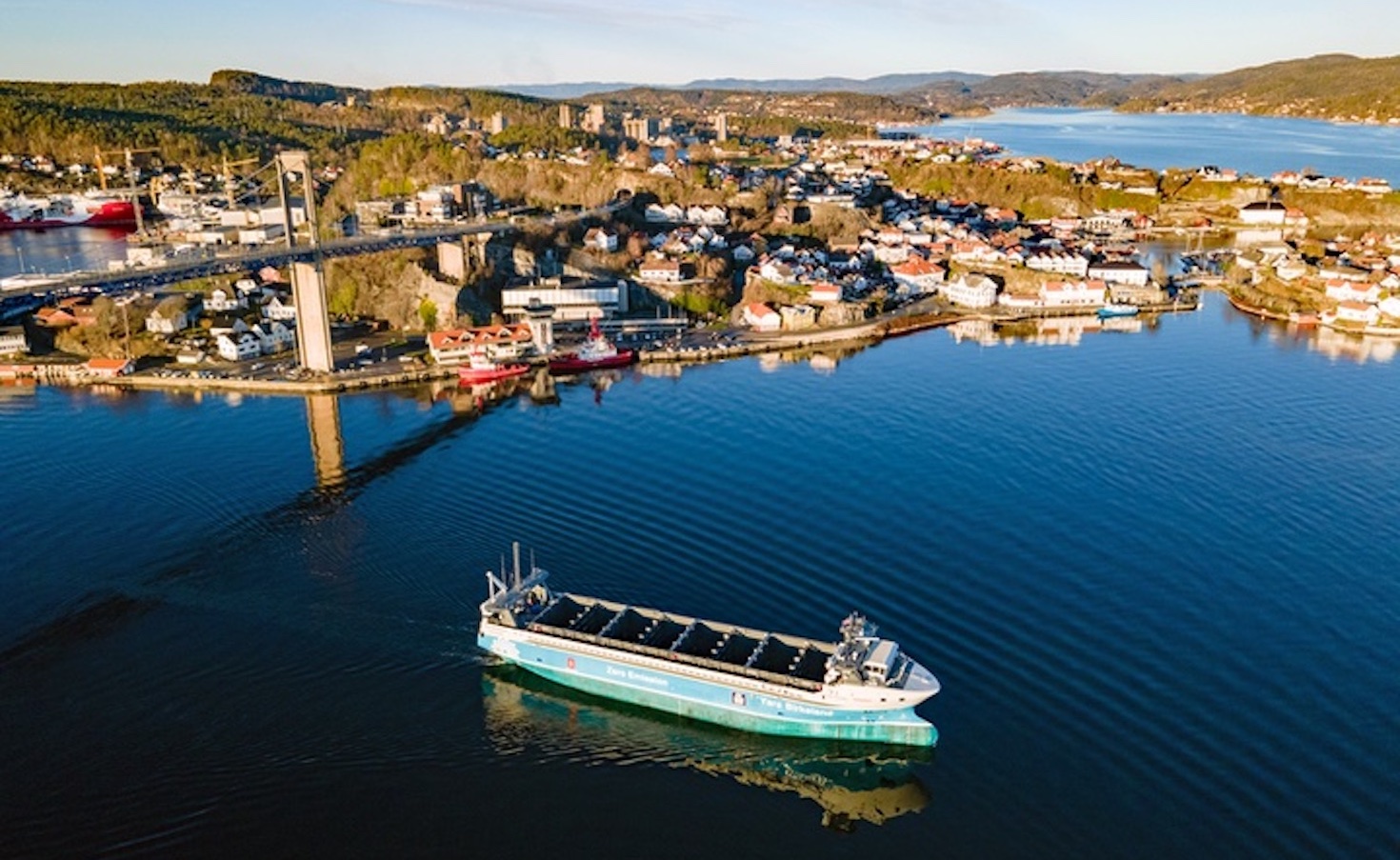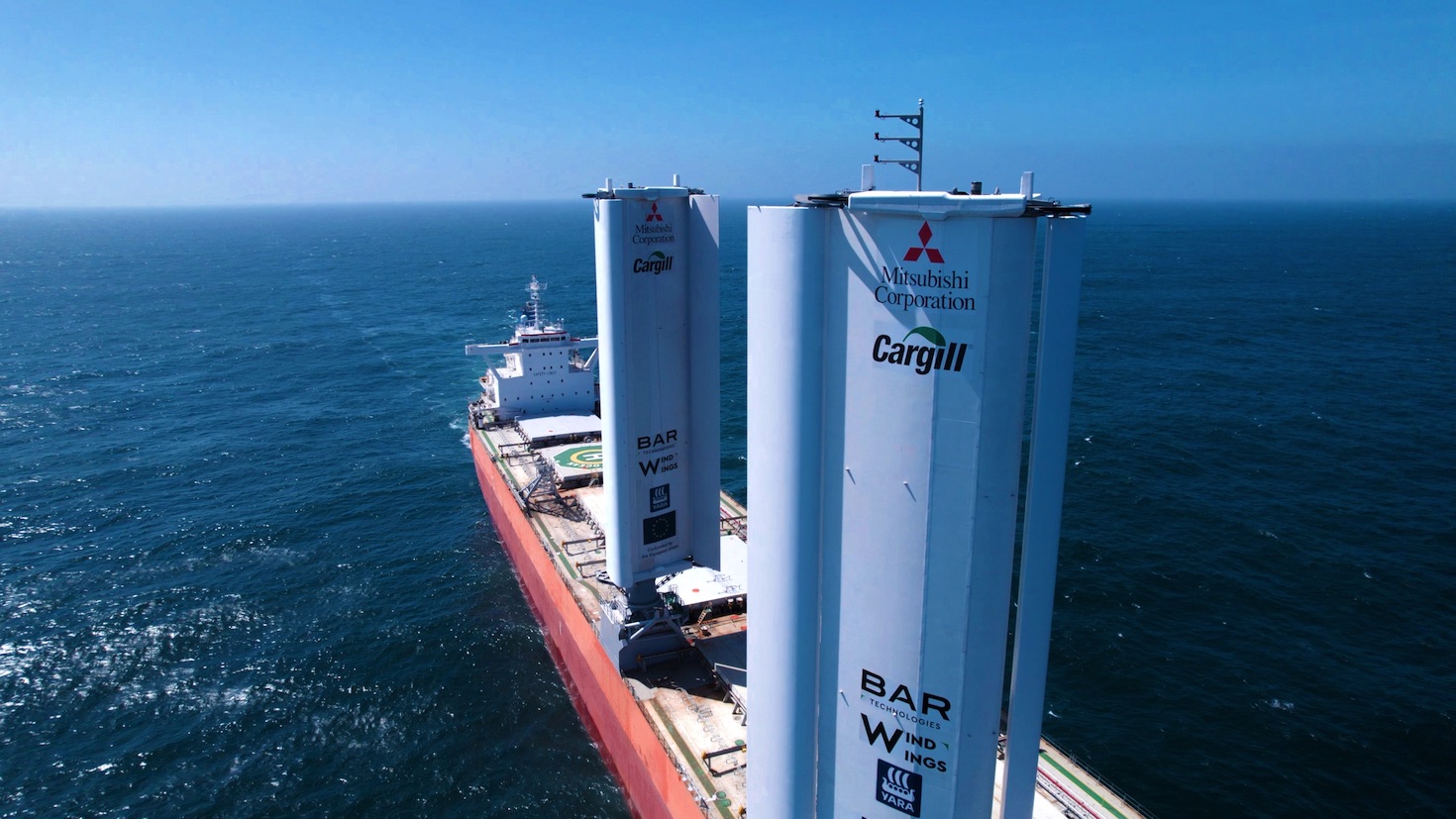The global food corporation Cargill recently chartered a cargo ship outfitted with giant, emission-cutting sails, reviving a millennia-old tradition of crossing the oceans using the wind. Developed by U.K.-based BAR Technologies, these steel and glass “WindWings” are a potentially sustainable route forward for the notoriously emission-heavy shipping industry.
At 123 feet tall, WindWings are made of the same material as wind turbines. They are designed to cut a cargo ship’s diesel fuel usage by roughly 20 percent. They operate largely in the same way as traditional fabric sails, but require minimal to no labor as they mechanically adjust themselves to take advantage of the wind.

![]()
The international shipping sector contributes around 2-3 percent of global greenhouse emissions annually, according to the International Energy Agency. At its current rate, the International Council on Clean Transportation estimates emissions will grow an additional 16 percent by 2030.
“Wind is a near-marginal, cost-free fuel and the opportunity for reducing emissions, alongside significant efficiency gains in vessel operating costs, is substantial,” said the CEO of BAR Technologies, John Cooper, in a statement.
Jan Dieleman, president of Cargill’s ocean transportation business, agreed with Cooper’s sentiments, saying in a separate statement, “At Cargill we have a responsibility to pioneer decarbonizing solutions across all our supply chains to meet our customers’ needs and the needs of the planet.”
Autonomous electric ships are already sailing — just not very far
Cargill isn’t alone. Fertilizer company Yara International developed a completely electric and autonomous container vessel dubbed Yara Birkeland. The emissions-free ship, which made its maiden voyage in 2021, sails the route between Yara’s plant in southern Norway to its export port just under 9 miles away.
Electrification is not currently an option for long-haul ocean voyages. That’s simply because our battery technology isn’t there yet.
What makes Yara Birkeland logistically feasible is the short distance. “Electrification is not currently an option for long-haul ocean voyages,” said Ingrid Irigoyen, associate director of ocean and climate at the Aspen Institute. “That’s simply because our battery technology isn’t there yet.”
But that doesn’t mean other alternatives aren’t currently available for cargo ships. Irigoyen believes that the way forward will require a mix of solutions, such as lower-emission fuels such as green methanol and ammonia. “My hope is that we’ll see adoption of new fuels right away, and that [they] will be coupled with technologies like wind that can maximize efficiency.”

![]()
![]()
![]()
![]()
![]()
![]()
![]()
![]()
![]()
![]()
![]()
![]()
The goal: Cutting emissions by 70 percent
The International Maritime Organization set a goal to reduce carbon emissions from international shipping by 40 percent by 2030 and 70 percent by 2050 versus 2008 levels. To reach these numbers, two mandatory measures were introduced; the Energy Efficiency Existing Ship Index (EEXI) and the Carbon Intensity Indicator (CII) rating scheme.
The EEXI measures each ship’s energy efficiency — based on metrics including energy consumption, speed and engine size. The CII links greenhouse gas emissions to the amount of cargo carried by each ship relative to the distance traveled. The subsequent results will then be rated on a scale from A to E, with poor performing ships required to enact corrective action.
“We need to see the development of a robust, competitive market for very low emission, or zero emissions, solutions,” said the Aspen Institute’s Irigoyen. To that end, Cargill and BAR will observe the efficacy and performance of the WindWing sails currently at sea. Ultimately, real-time feedback will improve the design and enhance the scaleup of the technology.
- SEO Powered Content & PR Distribution. Get Amplified Today.
- PlatoData.Network Vertical Generative Ai. Empower Yourself. Access Here.
- PlatoAiStream. Web3 Intelligence. Knowledge Amplified. Access Here.
- PlatoESG. Carbon, CleanTech, Energy, Environment, Solar, Waste Management. Access Here.
- PlatoHealth. Biotech and Clinical Trials Intelligence. Access Here.
- Source: https://www.greenbiz.com/article/cargill-using-giant-sails-its-cargo-fleet-cut-greenhouse-emissions
- :is
- :not
- 15%
- 16
- 20
- 2008
- 2021
- 2023
- 2030
- 2050
- 40
- 70
- 9
- a
- According
- across
- Action
- Additional
- adjust
- Adoption
- ADvantage
- agency
- All
- alone
- alongside
- already
- alternatives
- amount
- an
- and
- Annually
- ARE
- around
- AS
- Associate
- At
- autonomous
- available
- away
- bar
- based
- battery
- BE
- because
- believes
- between
- business
- but
- by
- CAN
- carbon
- carbon emissions
- Cargill
- Cargo
- Center
- ceo
- chains
- Chartered
- click
- Climate
- company
- competitive
- completely
- consumption
- Container
- contributes
- cooper
- CORPORATION
- Costs
- Council
- coupled
- Current
- Currently
- Cut
- cutting
- data
- Design
- designed
- developed
- Development
- dhl
- diesel
- Director
- distance
- Doesn’t
- dubbed
- e
- each
- efficacy
- efficiency
- Electric
- emission
- Emissions
- end
- energy
- Energy Consumption
- Engine
- enhance
- Ether (ETH)
- existing
- export
- fabric
- feasible
- feedback
- Feet
- fertilizer
- FLEET
- food
- For
- Forward
- from
- Fuel
- fuels
- Gains
- GAS
- giant
- glass
- Global
- goal
- greenhouse gas
- Greenhouse gas emissions
- Grow
- Have
- hope
- HTML
- HTTPS
- IEA
- improve
- in
- Including
- Institute
- International
- introduced
- ITS
- John
- jpg
- just
- labor
- largely
- levels
- like
- Low
- made
- MAKES
- mandatory
- Maritime
- Market
- material
- Maximize
- mean
- measures
- Meet
- Metrics
- minimal
- mix
- move
- my
- Need
- needs
- New
- no
- Norway
- numbers
- observe
- ocean
- oceans
- of
- on
- operate
- operating
- Opportunity
- Option
- or
- organization
- Other
- our
- percent
- performance
- performing
- pioneer
- planet
- plato
- Plato Data Intelligence
- PlatoData
- poor
- potentially
- presentation
- president
- Rate
- rated
- rating
- reach
- real-time
- recently
- reduce
- reducing
- reducing emissions
- relative
- require
- required
- responsibility
- Results
- right
- robust
- Route
- Said
- sailing
- same
- saying
- Scale
- scheme
- SEA
- sector
- see
- sentiments
- separate
- set
- Shipping
- ships
- Short
- significant
- simply
- Size
- Solutions
- Southern
- speed
- steel
- subsequent
- substantial
- such
- supply
- Supply chains
- sustainable
- Take
- Technologies
- Technology
- that
- The
- themselves
- then
- There.
- These
- they
- to
- tradition
- traditional
- transportation
- traveled
- two
- Ultimately
- under
- Usage
- using
- Versus
- very
- Vessel
- Voyage
- Way..
- we
- were
- which
- will
- wind
- with
- yet
- zephyrnet
- zero







